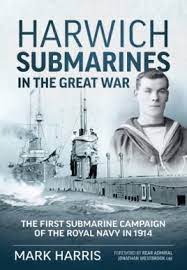By Mark Harris; Helion, Warwick, UK, (2021).
Reviewed By Capt. Richard Dick, USN (Ret.)
Harwich Submarines in the Great War is the detailed story of the 1914 British overseas submarine campaign. “Detailed” really does not do the author justice. Mark Harris’s research is little short of astonishing. He has plumbed British, German, and French archives, the papers of Adm. Roger Keyes, RN (Commodore in Charge, Submarine Service, 1912-1914), and the British and German official histories to tell the story, in depth, of every British offensive submarine patrol in the North Sea in 1914 (and the 1914 Baltic patrols) from the outbreak of war in August through the end of the year. He has reconstructed and drawn corrected charts for each patrol. He discusses every British senior officer connected with the campaign, every submarine commanding officer (including relevant comments from their fitness reports), many subordinate officers in the more than 20 British (and one French) submarine wardrooms, and key crew members of each vessel. Harris focuses on the men but includes more than enough of the technical characteristics and details to enable the reader to understand the constraints, capabilities, and weaknesses of these, the first British submarines to be used in combat outside U.K. coastal waters.
At the outbreak of war, the Royal Navy concentrated its newest and most capable submarines, the D and E classes, at Harwich on the North Sea as the 8th Submarine Flotilla. The flotilla was part of the Royal Navy Submarine Service, under the command of then-Commodore Roger J.B. Keyes. The E Class would become the most famous British submarines of the war, thanks largely to the exploits of two of Keyes’ commanding officers, Lt. Cdr. Max Horton and Lt. Cdr. Martin Naismith.
The E class boat was crewed by three officers and about 27 enlisted men. On the surface, diesel engines propelled it at a maximum speed of 15 knots for about 2600 miles. Submerged, battery-powered electric motors could take the boat up to about 65 miles at 5 knots. Armament consisted of four to five 18-inch torpedo tubes (one or two in the bow, one in the stern, and one each firing athwartships to port and starboard) and 8-10 weapons (the vessels carried no deck gun). E Class units were being fitted during 1914 with radio (good to about 50 miles). The 181 foot submarine was divided into three or four watertight compartments and could submerge to a design maximum depth of 100 feet (although boats exceeded this on several occasions). The only effective sensor system was visual detection, either from lookouts on the surface or through the mediocre periscope when submerged.
By December 1914, E Class units were operating at sea up to 18 days. Food was generally canned, monotonous, and often served cold, since the oven and hotplate consumed precious battery power submerged. Crews spent much time on the surface, often in the teeth of North Sea winter gales that smashed bridge screens and sometimes bent bow planes.
Harris describes meticulously the people, doctrine, and training of the submarine force. He acknowledges that in 1914 the 8th Flotilla sank few German ships (the scout cruiser SMS Hela and the torpedo boat destroyer S-116) while losing three of its own units. However, he highlights the real achievement of the 1914 campaign– by December, the major surface units of the German High Sea Fleet had been largely confined to port and most of their at-sea training had been shifted to the Baltic. Fear of British submarines largely drove these changes. While the major units could and did deploy for fleet actions, they had vacated the North Sea for routine operations.
Harris is a prodigious researcher and an effective (if not thrilling) writer. He has illustrated the book with a number of excellent photographs and his own very good charts. Harwich Submarines is apparently his first book; hopefully his subsequent work will live up to the very high standards he has set in this work.
Captain Dick is a retired submariner; he also served over 29 years in the defense intelligence community.
Mark Harris is a military historian who studies World War I naval matters. He previously worked in the financial services sector, but now focuses his historical research on sifting new nuggets from familiar archives and memoirs.
Harwich Submarines in the Great War: The First Submarine Campaign of the Royal Navy in 1914. By Mark Harris (Warwick, UK: 2021).


